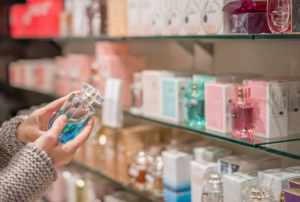Alluring Scents with Hidden Health Risks

Welcome, fragrance enthusiasts and health-conscious consumers, to The Fragrance Paradox—a journey through the captivating world of scents, where allure meets awareness. In this comprehensive beauty blog, we’ll delve into the intricate relationship between fragrances and health risks, exploring how seemingly innocuous scents can conceal potential dangers. As we unravel this paradox, we’ll equip you with knowledge to make informed decisions about your fragrance choices, prioritizing both allure and well-being.
The Enchantment of Fragrances
The allure of fragrances is deeply ingrained in human history, dating back to ancient civilizations where aromatic herbs and oils were revered for their medicinal and spiritual properties. The Egyptians, renowned for their sophisticated perfumery techniques, used fragrances in religious ceremonies and as offerings to their gods. Similarly, in ancient India and China, fragrances were valued for their therapeutic benefits and were an integral part of traditional healing practices such as Ayurveda and Traditional Chinese Medicine.
Fast forward to the modern era, and the art of perfumery has evolved into a multi-billion-dollar industry, with an extensive array of scents catering to every taste and preference. From the iconic Chanel No. 5 to the contemporary creations of niche perfumeries, fragrances have become an essential accessory in our daily lives, symbolizing elegance, sophistication, and individuality.
Beyond their aesthetic appeal, fragrances hold a profound psychological influence on our mood, behavior, and perception of others. Numerous studies have demonstrated the link between scent and emotion, with certain fragrances eliciting feelings of happiness, relaxation, or arousal. The scent of lavender, for instance, is renowned for its calming properties, making it a popular choice for aromatherapy and relaxation treatments. In contrast, the invigorating aroma of citrus fruits can uplift the spirits and boost energy levels, making it an ideal choice for morning rituals or midday pick-me-ups.
Moreover, fragrances play a pivotal role in shaping our social interactions and romantic encounters. The right scent has the power to captivate attention, evoke desire, and leave a lasting impression on others. Whether it’s the subtle allure of a floral bouquet or the sensual embrace of musk and amber, fragrances can enhance our allure and confidence, acting as a silent yet potent expression of our personality and sensuality.
At the heart of the fragrance industry lies the intricate art of perfumery, where master perfumers meticulously blend aromatic ingredients to create olfactory masterpieces that captivate the senses. Each perfume is composed of a harmonious blend of top, middle, and base notes, carefully selected to create a multi-dimensional fragrance experience.
The top notes, also known as the “head notes,” are the initial impression of the fragrance, offering a burst of freshness and vitality that entices the senses. These volatile molecules evaporate quickly, giving way to the heart or middle notes, which form the core of the fragrance and provide its distinctive character and personality. Finally, the base notes, with their rich and lingering aroma, anchor the fragrance, providing depth, warmth, and longevity.
From rare botanical essences sourced from around the world to synthetic molecules crafted in the laboratory, perfumers have an extensive palette of ingredients at their disposal, allowing them to create an infinite variety of fragrances to suit every taste and occasion. However, behind the veil of enchantment lies a hidden paradox—a shadowy world where the allure of fragrances conceals potential health risks that often go unnoticed.
While fragrances have the power to enchant and seduce, they also harbor hidden health risks that pose a dilemma for consumers and regulators alike. Despite their widespread use, many fragrances contain synthetic chemicals that have been linked to a range of health concerns, including allergies, respiratory problems, and hormonal disruption.
One of the main culprits is a group of chemicals known as phthalates, which are commonly used as fixatives in fragrances to prolong their scent. Phthalates have been associated with adverse effects on reproductive health, including reduced sperm count, infertility, and developmental abnormalities in children. Furthermore, many fragrances contain volatile organic compounds (VOCs) such as benzene and formaldehyde, which can contribute to indoor air pollution and exacerbate respiratory conditions such as asthma.
Moreover, the lack of transparency in the fragrance industry makes it difficult for consumers to make informed choices about the products they use. While manufacturers are required to list ingredients on product labels, fragrances are often protected as trade secrets, allowing companies to withhold information about potentially harmful chemicals.
In light of these concerns, consumers are increasingly seeking out natural and organic alternatives that offer the allure of fragrances without the hidden health risks. Niche perfumeries and artisanal brands are leading the way with their commitment to using ethically sourced ingredients and transparent labeling practices, allowing consumers to enjoy the enchantment of fragrances with peace of mind.
Moreover, advancements in fragrance technology are paving the way for innovative alternatives that harness the power of nature to create captivating scents without compromising on safety. From botanical extracts and essential oils to sustainable fragrance molecules derived from renewable sources, these eco-friendly alternatives offer a greener and healthier approach to perfumery.

Decoding Fragrance Labels
While fragrances offer sensory pleasure and emotional gratification, they also harbor hidden health risks that often go unnoticed. The allure of synthetic fragrances can mask a plethora of potentially harmful chemicals, including phthalates, parabens, and synthetic musks, among others. These compounds have been linked to various health concerns, ranging from skin irritation and respiratory issues to hormone disruption and even carcinogenic effects. Despite their pervasive presence in everyday products, the long-term consequences of continuous exposure to these chemicals remain a subject of growing concern among health professionals and consumers alike.
In the enchanting world of fragrances, the allure of scents often captivates our senses, drawing us in with promises of elegance and sophistication. However, behind the veil of enchantment lies a realm of mystery and complexity, where deciphering fragrance labels can be a daunting task for even the most seasoned consumers. In this chapter, we embark on a journey to unravel the secrets concealed within fragrance labels, shedding light on the ingredients, regulations, and terminology that shape our olfactory landscape.
At first glance, a fragrance label may seem like a cryptic puzzle, adorned with an array of symbols, abbreviations, and unfamiliar terms. However, by breaking down the components of a fragrance label, we can gain valuable insights into the composition and quality of the product.
1. Product Name: The product name typically reflects the brand and specific fragrance, offering a glimpse into the scent’s inspiration or key ingredients. Whether it’s a whimsical floral bouquet or a sultry blend of spices, the product name sets the tone for the olfactory experience that awaits.
2. Brand Information: The brand information includes the name of the manufacturer or distributor, providing assurance of quality and authenticity. Established brands with a long-standing reputation for excellence often prioritize transparency and adhere to stringent quality standards.
3. Ingredients List: The ingredients list is perhaps the most important component of a fragrance label, offering a comprehensive breakdown of the raw materials used to create the scent. However, deciphering fragrance ingredients can be challenging due to the industry’s lack of transparency and the prevalence of proprietary blends. While some brands provide detailed ingredient lists, others may opt for generic terms such as “fragrance” or “parfum,” making it difficult to discern the specific chemicals present.

Fragrances are composed of a complex blend of aromatic compounds, solvents, and fixatives, each contributing to the scent’s character and longevity. While natural ingredients such as essential oils and botanical extracts are prized for their purity and authenticity, synthetic chemicals are often used to enhance stability and prolong scent duration. It’s essential for consumers to be aware of common fragrance ingredients and their potential health effects:
1. Essential Oils: Derived from plants and botanicals, essential oils are prized for their aromatic properties and therapeutic benefits. However, not all essential oils are created equal, and some may cause allergic reactions or skin sensitivities in certain individuals.
2. Synthetic Fragrance Chemicals: Synthetic fragrance chemicals, such as phthalates, musks, and aldehydes, are commonly used in perfumery to mimic natural scents and enhance fragrance longevity. While these chemicals are subject to regulatory oversight in some countries, they have been linked to a range of health concerns, including allergies, respiratory problems, and hormonal disruption.
3. Solvents and Fixatives: Solvents such as alcohol or glycol are used to dissolve and dilute fragrance ingredients, while fixatives help to stabilize the scent and prolong its duration. While these ingredients are generally considered safe when used in low concentrations, they may contribute to skin irritation or sensitization in sensitive individuals.
Regulatory oversight of fragrance ingredients varies significantly between countries, with some jurisdictions imposing strict labeling requirements and ingredient restrictions, while others adopt a more lenient approach. In the European Union, for example, the Cosmetics Regulation mandates the disclosure of fragrance allergens above certain concentration thresholds, providing consumers with greater transparency and safety. In contrast, the United States does not require fragrance manufacturers to disclose specific ingredients due to trade secret protections, leaving consumers in the dark about potential health risks.
Natural Alternatives and DIY Solutions
In light of the hidden health risks associated with synthetic fragrances, many consumers are turning to natural alternatives and DIY solutions. Essential oils, derived from plants and botanicals, offer a safer and more sustainable option for fragrance enthusiasts seeking to avoid synthetic chemicals. From lavender and eucalyptus to citrus and vanilla, there’s a vast array of essential oils available, each with its unique aroma and potential health benefits. Additionally, DIY enthusiasts can experiment with creating their fragrances using natural ingredients, such as herbs, spices, and floral extracts, to tailor their scents to their preferences while minimizing exposure to harmful chemicals.

As consumers become increasingly aware of the hidden health risks associated with synthetic fragrances, there is a growing demand for transparency and accountability within the fragrance industry. Organizations and advocacy groups are calling for stricter regulations and labeling requirements to ensure that consumers have access to accurate information about the products they purchase. By advocating for greater transparency and accountability, we can empower consumers to make informed choices about their fragrance preferences and prioritize their health and well-being.
In conclusion, The Fragrance Paradox highlights the complex interplay between allure and health risks within the world of fragrances. While scents have the power to captivate our senses and enhance our daily lives, they also conceal hidden dangers that can impact our health and well-being. By understanding the potential risks associated with synthetic fragrances, deciphering fragrance labels, exploring natural alternatives, and advocating for transparency and accountability, we can navigate this paradox with confidence and make choices that prioritize both allure and health. Join us on this journey of discovery as we unravel the mysteries of fragrance and embark on a path towards a safer, healthier future.




